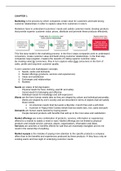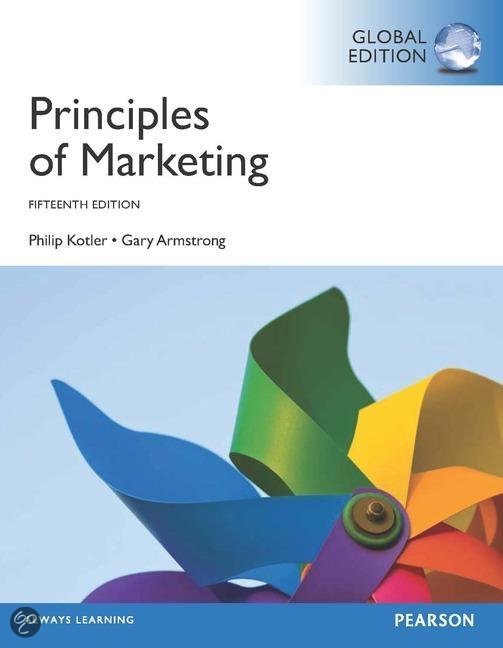CHAPTER 1
Marketing is the process by which companies create value for customers and build strong
customer relationships in order to capture value from customers in return.
Marketers have to understand customers’ needs and satisfy customer needs; develop products
that provide superior customer value; prices, distribute and promote these products effectively.
This five-step model is the marketing process. In the first 4 steps companies work to understand
consumers, create customer value and build strong customer relationships. In the final step,
companies reap (oogsten, maaien) the rewards of crating superior customer value.
By creating value for consumers, they in turn capture value from consumers in the form of
sales, profits and long-term customer quality.
5 core customer and marketplace concepts:
1. Needs, wants and demands
2. Market offerings (products, services and experiences)
3. Value and satisfaction
4. Exchanges and relationships
5. Markets
Needs are states of felt deprivation.
- Physical needs for food, clothing, warmth and safety
- Social needs for belonging and affection
- Individual needs for knowledge and self-expression
Wants are the form human needs take as they are shaped by culture and individual personality.
- Wants are shaped by one’s society and are described in terms of objects that will satisfy
those needs.
o An American needs food but wants a Big Mac, French fries and a soft drink
o A person in Papua New Guinea needs food but wants taro, rice, yams and pork
Demands are human wants backed by buying power.
- People demand products with benefits that add up to the most value and satisfaction
Market offerings are some combination of products, services, information or experiences
offered to a market to satisfy a need or want. Market offerings are not limited to physical
products and include service, persons, places, organizations, information and ideas.
Services are activities or benefits offered for sale that are essentially intangible and do not
result in the ownership of anything.
Market myopia is the mistake of paying more attention to the specific products a company
offers than to the benefits and experiences produced by these products they focus only on
existing wants and lose sight of underlying customer needs.
,Customer value and satisfaction are key building blocks for developing and managing
customer relationships. If marketers set expectations too low, they may satisfy those who buy
but fail to attract enough buyers. If they set expectations too high, buyers will be disappointed.
Exchange is the act of obtaining a desired object from someone by offering something in return.
Market is the set of actual and potential buyers of a product or service.
This figure shows the main elements in a marketing system. Marketing involves serving a
market of final consumers in the face of competitors. The company and competitors research
the market and interact with consumers to understand their needs. Then they create and send
their market offerings and messages to consumers, either directly or through marketing
intermediaries. Each part in this system is affected by major environmental forces
(demographic, economic, natural, technological, political and social/cultural). Each party in the
system adds value for the next level.
Thus, a company’s success at building profitable relationships depends not only on its own
actions but also on how well the entire system serves the needs of final consumers.
Marketing management is the art and science of choosing target markets and building
profitable relationships with them.
The marketing managers aim is to finds, attract, keep and grow target customers by creating,
delivering and communicating superior customer value.
To design a winning marketing strategy, the marketing manager must answer 2 important
questions:
1. What customers will we serve (what’s our target market)?
Whom will it serve?
market segmentation is dividing the marketing into segments of customers.
Target marketing is selecting which segment a company will go after dividing it into
segments.
2. How can we serve these customers best (what’s our value position)?
How will it serve differentiate and position itself.
Value proposition is the set of benefits or values a brand promises to deliver to
consumers to satisfy their needs.
,There are 5 concepts under which organizations design and carry out their marketing strategies:
1. The Production Concept consumers will favor products that are available and highly
affordable; therefore, the organization should focus on improving production and
distribution efficiency.
2. The Product Concept consumers will favor products that offer the most quality,
performance and features; therefore, the organization should devote its energy to
marketing continuous products improvements.
3. The Selling Concept (followed by many company’s) consumers will not buy enough
of the firm’s products unless the firm undertakes a large-scale selling and promotion
effort.
4. The Marketing Concept knowing the needs and wants of target markets and
delivering the desired satisfactions better than competitors do.
5. The Societal Marketing Concept make good marketing decisions by considering
consumers’ wants and long-term interest company’s requirements, consumers’ long-run
interest, and society’s long-run interests.
Customer Relationship Management is the overall process of building and maintaining
profitable customer relationships by delivering superior customer value and satisfaction.
Customer-perceived value is the difference between total customer value and total customer
cost.
Customer satisfaction is the extent to which a product’s perceived performance matches a
buyer’s expectations
Basic relationship = no personal contact with the customers.
Full partnerships = personal contact with the customers.
Frequency marketing programs are to reward customers who buy frequently or in large
amounts.
Club marketing programs offer members special benefits and create member communities.
Customer lifetime value is the value of the entire stream of purchases a customer makes over
a lifetime of patronage.
Share of customer is the portion of the customer’s purchasing that a company gets in its
product categories.
Customer equity is the total combined customer lifetime values of all of the company’s
customers.
, See page 50-51
CHAPTER 2
Strategic planning is the process of developing and maintaining a strategic fit between the
organization’s goals and capabilities and its changing marketing opportunities.
Steps in Strategic planning:
1. Defining the company mission
2. Setting company objectives and goals corporate level
3. Designing the business portfolio
4. Planning marketing and other functional strategies business unit, product and
market level
Mission statement is a statement of the organization’s purpose – what it wants to accomplish
in the larger environment.
Market-oriented mission statement defines the business in terms of satisfying basic customer
needs.
Business objectives:
- Build profitable customer relationships
- Invest in research
- Improve profits
Marketing objectives:
- Increase market share
- Create local partnerships
- Increase promotion
This figure shows the major activities involved in
managing a customer-driven marketing strategy and
marketing mix.
Consumers are in the center. The goal is to create
value for customers and build profitable
customer relationships. Next comes marketing
strategy. After the marketing strategy comes
the marketing mix. To find the best marketing
strategy and marketing mix, the company
engages in marketing analyzing, planning,
implementation, and control.
Marketing strategy is the marketing logic by which
the company hopes to create customer value
and achieve profitable customer relationships.
- Segmentation and targeting
- Differentiation and positioning
Each company must dive up the total market, choose
the best segments and design strategies for profitably
serving chosen segments.
Market segmentation is the division of a market into distinct groups of buyers who have
different needs, characteristics, or behaviors and who might require separate products or
marketing programs.
Marketing segment is a group of consumers who respond in a similar way to a given set of
marketing efforts.






